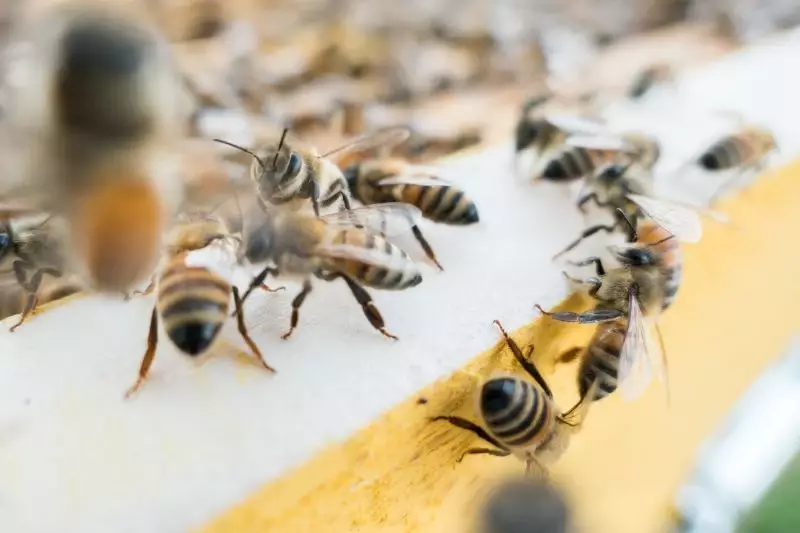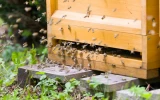Beehive Temperature: What's Too Hot, Too Cold, & Optimal?
Bees, like any other insect, are particular about the temperature of their home. They must maintain an ideal beehive temperature that will be just enough to keep their brood alive. To get to know the optimal temperature range for a beehive in case you plan to put up bee farms or just plainly want to try taking care of one, keep reading below.
For bees and their brood to survive, the beehive temperature must be kept between 94 and 96°F (34.5 and 35.5°C), regardless of the surrounding temperature. When the temperature falls outside this optimal range, it will have a detrimental effect on the colony, which may lead to their death.
Bees, however, are made to tolerate extreme temperatures and have certain adaptations to deal with them, but they too, like humans, have limits. When the temperature gets too cold or too hot for them to handle, bees die. But exactly what temperature range is considered too hot or too cold for them? Find out more below.
Summary
- The optimal beehive temperature must be kept between 94 and 96°F (34.5 and 35.5°C) for the bees' survival.
- Too hot or too cold temperatures can affect bees and cause the death of a bee colony.
- Bees have adapted ways to cope with temperatures deemed too hot or too cold for their brood survival.

On this page:
The Ideal Beehive Temperature in Details
Bees are tolerant insects that have adapted ways to survive extreme weather conditions. A study of different honeybee variants subjected to extreme temperature conditions has shown that bees exposed to warm tropical climates are more likely to have high endurance for hotter temperatures. At the same time, bees that are native to places with cooler climates will have a higher survival rate during very cold temperatures. This shows that different bee species have different degrees of optimal temperature and tolerances of extreme cold or heat.
Further research on honeybees revealed that the ideal temperature that must be maintained in the central brood area of their beehive must be around 32°C –36 °C (89.6 °F - 96.80 °F) for the colony to survive.
In one comparative study of California honeybees, it was proved that the optimal temperature for them is 95 °F (35 °C) and they were able to thrive and live for 2 weeks. However, when the temperature increased to 104 °F (40 °C), the bees only lasted for about 3 days. When the temperature is adjusted further to 113 °F (45 °C), the bees died in less than 24 hours.
| Temperature Range | Condition of Honeybees |
|---|---|
| 95 °F (35 °C) | Honeybees survived for 2 weeks |
| 104 °F (40 °C) | Honeybees only lasted for 3 days |
| 113 °F (45 °C) | Honeybees immediately died in less than 24 hours |
In this study, bees were exposed to constantly high temperatures, and it showed that at the maximum heat of 45 °C or 113 °F, bees will not be able to survive.
In terms of extreme cold, a study of honeybees shown that will die within an hour if the temperature falls below 28.4°F (- 2°C). If the temperature falls between 48.2 °F – 53.6 °F (9 – 12 °C), bees will undergo a chill-coma where they can survive for 50 hours, given that they are warmed back up to room temperature.
| Temperature Range | Condition of Honeybees |
|---|---|
| Below 28.4°F (- 2°C) | Honeybees died within 1 hour |
| 48.2 °F – 53.6 °F (9 – 12 °C) | Honeybees undergo a chill coma and can survive for 50 hours if warmed back to room temperature |
| 45 °C (113 °F) | Honeybees immediately died in less than 24 hours |
From this data, we can therefore say that the maximum cold temperature bees can hold is below 28.4°F (- 2°C).
Ways To Keep the Hive's Optimal Temperature Range When It's Cold Out
As discussed above, bees developed certain adaptations to keep their beehive temperature within the optimal range. During periods of extreme cold temperatures, bees do the following:
Muscle contraction
Amazing as it seems, honeybees can keep the hive warm by raising their own body temperature through contracting the muscles in their thorax, which is the middle part of an insect body where the wings are attached. In this process, the bees contract their wing muscles, much like how people shiver to get rid of the cold. This method requires plenty of energy which is why bees consume great amount of honey when it's cold, and why it's important to leave some honey in the hive.
Interestingly, aside from their wing muscles, bees can also squeeze themselves in onto capped cells by pressing their thorax, to heat up the pupae inside. They can also take the empty cells spaces to transfer heat to the neighboring pupae. Such geniuses, isn't it?

Forming a cluster
Another genius technique that bees use to keep the hive's internal temperature within the normal range is to form clusters. Clusters reduce the space in which heat can escape outside the hive, serving much like a barrier.
The cluster comprises of 2 layers – an outside layer where the bees stand side to side and the heads are facing inwards, and an inner layer where the bees are free to move. Those in the center will be the ones that will create the heat through muscle contraction, while those in the outer shell will act as the insulation to ensure that the heat being generated won't escape the hive.
They will then take turns moving from outer layer to inner layer and taking honey breaks in between (for energy source). This method can help maintain at least 13– 20 °C (55 °F – 68 °F) in the center of the hive.
Intricate hive design
The intricate architecture of the beehive is also one of their ways to get better ventilation. The honeycomb is one of the examples that bees use not just for storing honey and raising the larvae, but also for creating barriers when it's cold outside. They use the honeycomb design to better spread the cluster and provide a way to maintain the heat inside.
Ways To Keep the Hive's Optimal Temperature Range When Temperature Rises
Bees cannot go to beaches and dip, nor can they turn the air conditioner at a maximum level when extremely hot temperature starts to kick in, but they can sure do the following methods to keep their hive temperature ideal:
Fanning
Literally speaking, the worker bees fan their wings to keep the cool air current flow throughout the hive, bringing its temperature within the optimal range. In a study, bumble bees have been shown to lower the temperature of their hive by 10°F.
Evaporative cooling
When fanning isn't enough during extremely hot season, bees use water in addition to it. They collect water droplets and spread it on the cells and hang the droplets throughout the hive. After that, they use the fanning method to let the water evaporate, letting the cool air circulate inside much like how air conditioning works in our household.
However, in some bees, instead of hanging the water droplets, they use their proboscises or their mouth appendage to spread the water in the hive in a way that lets it evaporate fast. This method is called "tongue-lashing" and is a faster way to cool down the hive temperature.
Bearding
In contrast to clustering, bearding is creating space outside the hive. Bees leave the hive and form a cluster outside instead of inside, to let the heat escape, and for the air to flow better, therefore lowering the temperature inside the hive. You can learn everything about bearding here.

